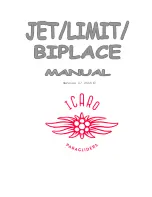
ALPHA Trainer
www.pipistrel-aircraft.com
REV. 0
POH-162-00-40-050
Normal procedures
Descent and final approach
Descent at speeds at or below VNO and flaps retracted.
For approach reduce speed to 70 kts (130 km/h) and set flaps to (+1) before turning to base leg.
Fuel pump switch: ON (if applicable - see chapter 7)
Adjust engine power to maintain proper airspeed. Set trim to neutralise stick force if necessary.
During the descent monitor temperatures and keep them within operational limits.
CAUTION!
During the descent engine power MUST be reduced. Should you be forced to de-
scend at idle power, make sure you keep adding throttle for short periods of time, not to turn the
spark plugs dirty and minimize the risk of ice formation on carburetors.
On final, set flaps to (+2).
Align with the runway and reduce power to idle.
Maintain an airspeed of 55 kts
(102 km/h)
.
Use throttle to control your descent glide path, otherwise control your attitude and crab if necessary.
NOTE
For flapless approach and landing increase speeds by 5 kts.
NOTE
Flapless landings are permitted only during day-time operations.
NOTE
See SPOH-161-00-41-050 - Electric airbrakes POH supplement - for information about use of
airbrakes (optional).
CAUTION!
Crosswind landings require higher final approach speeds to ensure aircraft’s safe
maneuverability. Increase the approach speed by 1 kts for every 1 kts of crosswind component e.g.
in case of 5 kts crosswind component, increase the approach speed by 5 kts.
Roundout and touchdown
CAUTION!
See chapter “Performance” for landing performance.
Roundout and touchdown (flare) occurs at following airspeeds:
Calm air, aircraft at MTOM
40 kts
(75 km/h)
IAS
Rough air, aircraft at MTOM (incl. strong crosswinds up to 34 km/h
(18 kts)
) 42 kts
(78 km/h)
IAS
CAUTION!
Land the aircraft in such a manner that the two main wheels touch the ground first,
allow the nose-wheel touchdown only after speed has been reduced below 25 kts. When lowering
the nose wheel to the runway the rudder MUST NOT be deflected in any direction (rudder pedals
centered).
CAUTION!
Elevated speeds must be used when landing with flaps retracted.
When on ground, start braking action holding the control stick in full back position. Provided the
runway length is sufficient, come to a complete standstill without engaging the brakes holding the
control stick slightly backwards as you slow down.
4-9
Summary of Contents for 890 AT 912 LSA
Page 2: ...This page is intentionally left blank...
Page 8: ...This page is intentionally left blank...
Page 10: ...This page is intentionally left blank...
Page 13: ...ALPHA Trainer www pipistrel aircraft com REV 0 POH 162 00 40 050 3 view drawing General 1 3...
Page 28: ...This page is intentionally left blank...
Page 34: ...This page is intentionally left blank...
Page 52: ...This page is intentionally left blank...
Page 58: ...This page is intentionally left blank...
Page 70: ...This page is intentionally left blank...
Page 91: ...This page is intentionally left blank...
Page 93: ...This page is intentionally left blank...
















































